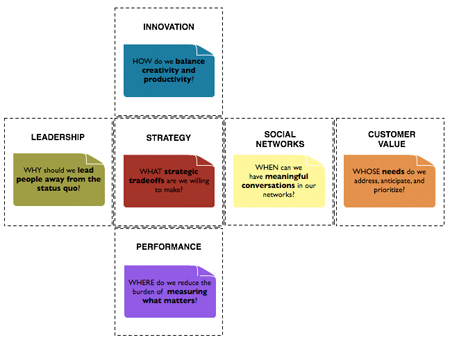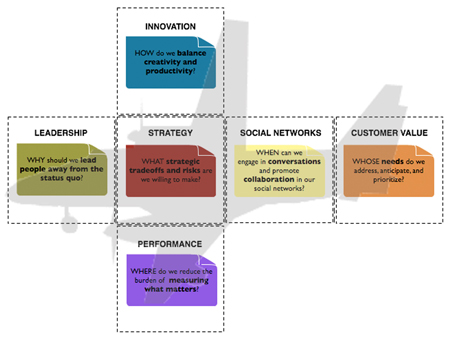Process Improvement Toolbox
- How to Perform a Walk-through
- How to Use the Nominal Group Technique
- Rapid-cycle testing: How to Conduct a Plan-Do-Study-ACT (PDSA) Cycle
- How to Flowchart
- How to Tell a Story
- How to Collect Data
- How to Establish a Change Team
- Visual Modeling Tools
- Creativity and Design
- Sustainability Model
- Getting Things Done
- Essential Team Behaviors
- Using Metaphors to Explore Continuous Improvement
- The Improvement Cafe
- Health Reform Readiness Index
- Technical Assistance Reports
- Recursos en Español
Using Metaphors to Explore Continuous Improvement
Organizations face tough, recurring questions as they adopt, nurture, and spread a culture of continuous process improvement. The diagram below shows some of these critical questions within key dimensions inside the organizational "cube." These questions resonate with experienced Change Leaders and Executive Sponsors, as they influence not only the success of specific change initiatives, but also broader issues such as workforce development, employee turnover, and the organization's financial bottom line.

Metaphors can be powerful tools for learning and communication, and we will use them to explore these six questions:
- Why should we lead people away from the status quo?
- How can we balance creativity and productivity?
- What strategic tradeoffs and risks are we willing to make?
- Where do we reduce the burden of measuring what matters?
- When can we engage in conversations and promote collaboration in our social networks?
- Whose needs do we address, anticipate, and prioritize?
Customer Value
Whose needs do we assess, anticipate, and prioritize?
Focusing on customer needs, as well as understanding and potentially involving customers in designing products, services, and experiences, is the key ingredient in any successful change effort. Mapping out who the "customers" are-patients, their families and peers, staff members, management, payors, the criminal justice system—is useful in identifying the stakeholders who will be affected by change, as well as in determining linkages and common needs.
Home in on customers' needs. For each customer group, you can use different strategies in concert to get a better picture of what customers require or desire. Surveys and suggestion boxes are useful in determining an effective range of what customers need, while interviews and focus groups delve into their motivations, preferences, and the critical incidents that trigger certain behaviors. Walk-throughs, while time consuming, are extremely useful in understanding first-hand what customers experience. Day-to-day observation unearths a multitude of invaluable small details, especially when they are incongruent with what customers say they do. Adopting a multi-pronged approach to understanding the customer also makes it easier to anticipate and prioritize customers' needs.
 |
Think out of the (cereal) box. Some useful questions in this regard can be inferred from something as mundane as a typical cereal box:
|
Innovation and Learning
How do we balance creativity and productivity?
Contrary to popular belief, Edison did not really invent the light bulb—he just made it better by making it last longer. After observing many filament breakages and the uneven blackening of bulbs (which was later coined the "Edison effect"), and after experimenting with hundreds of materials, he eventually found a way to solve the problem, by adding a more positively charged piece of foil that attracts electrons and causes current to flow. As a metaphor, the Edison effect shows that productivity is only one part of the equation—it is necessary to balance it with the positive charge of creativity in order to drive innovation and keep motivation high.
|
Mix people and assign roles. One way of doing this is through the selection of team members who will be part of a Change Project, and by defining specific roles for each of them. Organizing a Change Team composed of a mix of detail-oriented, artistic, and "just get-it-done!" personalities and assigning them specific roles (i.e., data expert, customer advocate, storyteller) provides more opportunities to create innovative solutions that meet deadlines. |
 |
Change the perspective. The structure and dynamics of brainstorming sessions also influence the quality of solutions that are generated, and in this regard, we can learn something from the world of improvisational comedy. The underlying philosophy of "improv" is simple: you want to make the other people on stage look good. This change of perspective is significant in brainstorming sessions, because the predominant reaction most of us have when presented with others' ideas is "yes, but...!" Saying "yes, and..." fundamentally changes our point of view, and facilitates building on or "hitchhiking" on the ideas our colleagues come up with, rather than shooting them down from the get go.
Strategic Management
What strategic trade-offs and risks are we willing to take?
When embarking on a change initiative, it is important to remember that there are always strategic trade-offs and risks that accompany decision-making. Our Change Team may have improved admissions, for example, but this solution might lead to a different set of problems down the road, such as longer waiting times and staff burnout due to a higher volume of customers in the system.
 |
Think systems. Adopting a holistic, systems perspective is necessary when dealing with dynamic, complex systems that involve people. Essentially, what this means is that a system's structure or environment affects processes and behaviors. This in turn influences outcomes and events, which are separated in time and space. Moreover, solutions developed by one Change Team often become a problem for the next. This is not unlike the dilemma people with credit card debt face: borrowing temporarily alleviates the problem, but it may snowball out of control in the long run. Without budgeting, this is certain to happen. |
Focus on the vital few. A Change Team needs to determine the root cause(s) of a problem and come up with a solution that lasts. The Pareto principle, also known as the "80-20 Rule," is a useful rule of thumb that reminds us that roughly 80 percent of adverse consequences is caused by a mere 20 percent of the potential causes. Change Leaders and teams can increase efficiency by identifying and addressing the "vital few" versus the "trivial many," as they provide the highest leverage in effectively solving the problem at hand.
Social Networks
When can we engage in conversations and promote collaboration?
In the Broken Telephone Game—otherwise known as Chinese Whispers—we learn the importance of direct communication. This game also presents the properties of an ideal inter-personal communication system:
- A clear message that is delivered unambiguously to the intended receiver(s)
- A medium that facilitates robust, speedy delivery
- A good listener who gives timely feedback
- A way to store the message and its exchange for future reference
- Zero background noise
|
Go right to the source. The more intermediaries we have between the source and the target in our organizational networks, the more likely our messages will get lost or misunderstood. Minimizing the distance messages travel is critical in getting things done in a timely manner, and is a prerequisite to having true conversations within our networks. Encouraging conversations at the workplace helps generate ideas, align personal incentives, and provide social support that is necessary in any work environment. Direct conversations help individuals understand and rally around a common goal, rather than be victims of fear, boredom, or indifference. |
 |
Capitalize on the Web. Social networking technology has grown over the past few years. Web sites such as MySpace, Second Life, and Facebook provide a channel for self-expression, and an avenue for social support, along with a means for personal goal-setting, group collaboration, and cross-pollination of ideas and information. The Internet also offers online "conversational technologies" like chat rooms, discussion fora, and web logs (i.e., www.wordpress.com, www.blogger.com) that enable organizations and Change Teams to be more connected with one another and with other organizations. Several maverick organizations already use these tools to connect directly with their own customers.
Performance Measurement
Where can we reduce the burden of measuring what matters?
Organizations are obsessed with outcomes and performance, yet few understand the value of measurement and even fewer give priority to establishing effective systems that monitor key decision-making variables. Einstein was once quoted as saying that "not everything that can be counted counts, and not everything that counts can be counted." This underscores the importance of measuring the things that really matter, at the same time understanding that the measurement process is by no means perfect. It is important to have well-defined goals and measures at the start of any change initiative. Well-defined goals and measures give direction and also provide motivation for adopting a philosophy of continuous process improvement.
 |
Develop a dashboard. A typical automobile dashboard has dials and gauges that measure the most important variables: speed, distance traveled, fuel remaining, temperature, voltage, and oil pressure. Other variables such gas mileage, ride comfort, and brake quality are equally important, as are warning lights and indicators that help ensure passenger safety. |
Tailor the task of measurement. Organizations and change initiatives should have a similar array of quantitative parameters that need to be monitored—such as overall growth, efficiency, productivity, and financial health—and these should be complemented by measures that pertain directly to specific groups, including customers, staff, management, and other external stakeholders. "Softer" measures in domains such as organizational learning (i.e., hours spent in training) and customer satisfaction (i.e., were customer needs met?) could provide deep insight and give a more balanced view of the impact of change initiatives.
Most people regard measurement, especially the day-to-day collection of data, an unnecessary chore. Some Change Teams reduce the burden by making measurement a shared responsibility: creating spreadsheets or charts that everyone updates in some way diffuses the burden and at the same time builds accountability and sensitivity to the need for measurement.
Leadership
Why should we lead people away from the status quo?
One of the most common barriers to change is the "Why fix it if it ain't broke?" argument: providing a good rationale for the need to change is necessary, especially for employees who have been in the organization longer, and for those whose work habits and rituals are deeply entrenched or inflexible.
|
Let the old dog teach new tricks. Athletes improving their speed and endurance sometimes do "Indian runs," where the last person in the group sprints to the front of the line, in successive fashion. Urging people in an organization to take turns leading, or allowing them to begin their own change projects—especially the ones who are familiar with the system—can be empowering and can have big payoffs by way of higher productivity as well as improved team morale. Experienced Change Leaders and Executive Sponsors can then serve as guides or coaches to those who are new to change management. |
 |
Show and tell. The best way to motivate people is to provide visible, tangible proof of the impact of change. Storyboards, brief reports and snapshots, as well as case studies, are important tools in disseminating the results and lessons learned in change initiatives.
In many ways, leading change is like flying a plane: there is a clear destination, and strategic tradeoffs and risks are taken to get there. How far and how fast one goes depends on the wings of innovation and performance measurement. Conversations add life to the passenger cabin; addressing customer needs is of paramount importance before, during, and after the flight.

The highly successful Japanese approach to manufacturing quality and productivity—kaizen—is also based on the principle of continuous improvement. Adopting such a philosophy, both at a personal and an organizational level, implies developing a culture of never being satisfied with the status quo, and always striving for excellence in the key dimensions of leadership, strategy, product/service innovation, and performance measurement. Consistently listening to the voice of the customer and effectively harnessing the power of organizational social networks hold the key to sustaining gains made.



